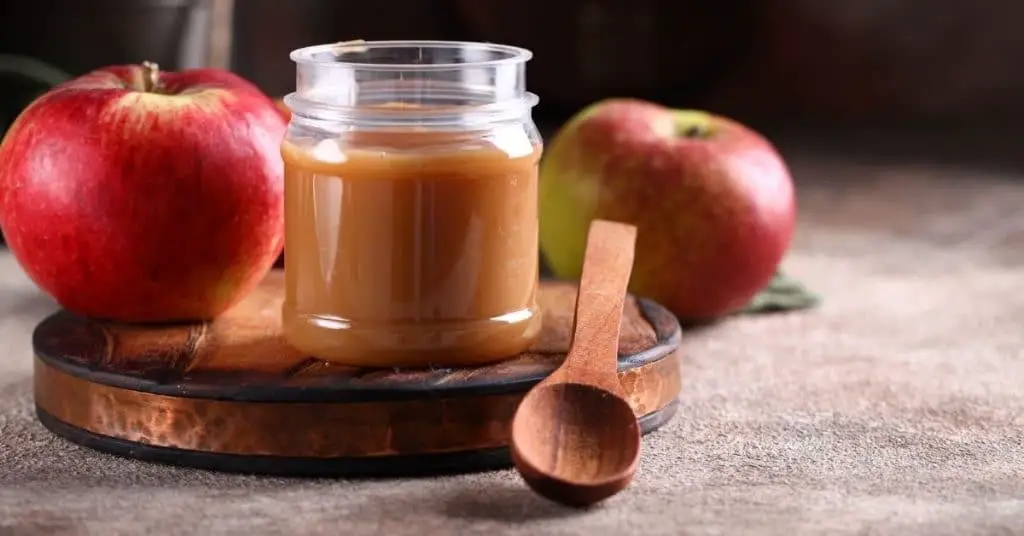In a nutshell: Yes, you can freeze applesauce to extend its shelf life and save preparation time, but make sure to protect it from air and moisture to prevent freezer burn. Freeze homemade applesauce soon after making it for the best quality.
Sweet or slightly tart, applesauce is used globally in a variety of cuisines. It is generally served as a condiment but can be incorporated into both sweet and savory dishes. This makes it a versatile ingredient to have around.
If you have made a large batch, the great news is that you can freeze homemade applesauce to prolong its shelf life and prevent food waste.
Below are step-by-step instructions and helpful tips for freezing applesauce successfully.
Can Applesauce Be Frozen?
Yes, you can freeze homemade applesauce as well as store-bought applesauce to prolong the shelf life of this condiment. Having a stash in the freezer also saves a lot of prep time.
When you freeze applesauce, it is important to protect it from contact with air and moisture to prevent freezer burn. It is also best to freeze homemade applesauce soon after it has been made to ensure an excellent quality product once thawed.
Applesauce that is nearing its expiry should not be frozen but rather used or thrown out.
How To Freeze Applesauce
Step 1: Cool
If you made fresh applesauce, it needs to cool completely before freezing.
Freezing homemade applesauce while still warm will cause large ice crystals to form which will cause freezer burn, ruining the texture, and flavor.
Step 2: Portion and Pack
To freeze applesauce in smaller portions, pour it into ice cube trays and place them in the freezer.
Once fully frozen, pop the cubes out of the ice cube trays and place them in resealable freezer bags, pressing out any excess air before sealing.
To freeze larger quantities, pour or scoop the desired portion sizes into resealable freezer bags. Carefully lay the bag flat, pressing out as much air as possible before sealing the bag.
Make sure to leave some headspace as the applesauce may expand slightly on freezing.
Step 3: Label
Label each freezer bag with the date so you can keep track of how long the applesauce has been frozen.
Step 4: Freeze
Cubes: Place the freezer bags with applesauce cubes in a cold part of the freezer which retains a consistent temperature.
Puree: Lie the bags of applesauce puree flat on a baking sheet and place it in the freezer to harden in an even layer.
Once hard, remove the baking sheet and stack the flat bags back in the freezer. This will save freezer space and allows the apple sauce to freeze and defrost evenly.
How To Thaw Frozen Applesauce
To defrost applesauce, remove the bag from the freezer and place it on a plate or in a bowl before putting it in the refrigerator. Let it thaw slowly overnight. The plate will catch any water dripping off the bag. Once thawed, give it a stir or quick blitz with a hand blender to ensure a smoother applesauce consistency.
If adding the applesauce to a soup, casserole, or sauce, it can be added from frozen. Applesauce ice cubes can be added straight to a smoothie without thawing.
Types of Applesauce
As its name suggests, applesauce is made mainly of apples, peeled or unpeeled. The apples are cooked in a large pot with water, apple juice, or apple cider and the addition of lemon juice, citric acid, or ascorbic acid for color preservation and safe storage.
Once the apples are soft, they are pureed with an immersion blender until perfectly smooth. Alternatively, they can be mashed with a potato masher to make a chunkier applesauce.
Brown sugar and spices such as cinnamon and allspice are occasionally incorporated for extra flavor in spiced versions—a delicious applesauce for the holidays!
A range of apple varieties are used to make homemade applesauce—yielding various flavor profiles from sweet to slightly tart. Acidic apple varieties such as Bramley apples produce a finer puree than sweet apples.
This inexpensive and easy-to-make condiment is also widely available in grocery stores. Commercial applesauce may contain additional preservatives to enhance the shelf life, color, and consistency of the product.
Applesauce is used in soups, or to accompany pork, turkey, or sausage in savory dishes.
Versatile in its use, it can also be added as a cake filling, used as an ingredient in muffins, cookies, or quick breads, and added to oatmeal for a breakfast bowl. You can blend it into a smoothie mix or use it as an oil replacement in certain baking recipes as a healthier alternative.
FAQs
Conclusion
Homemade apple sauce is deliciously sweet, tart, and way too good to waste. Versatile for use in sweet and savory applications, it is the perfect condiment to have on hand to spruce up breakfast, lunch, tea, or dinner.
Freeze leftover applesauce in individual portions for smoothies or larger portions for use in family meals or baking. Besides having a delicious sauce on hand at the drop of a hat, freezing applesauce is a great way to save time, money, and prevent food waste.
Up next: Can you freeze cranberry sauce?
*Image Dream79/depositphotos









